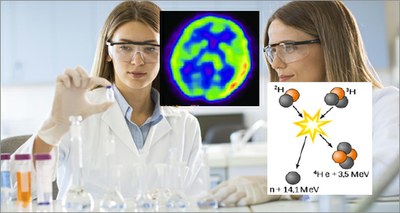Innovation: ENEA patents device for manufacturing radiopharmaceuticals with nuclear fusion
18/2/2021
 ENEA researchers at the Brasimone (Bologna) and Casaccia (Rome) laboratories have patented a device to increase the production yield of radiopharmaceuticals to diagnose and treat tumors and other diseases. The method is based on an environment-friendly nuclear fusion process, alternative to that used to produce radioisotopes for nuclear medicine in fission reactors.
ENEA researchers at the Brasimone (Bologna) and Casaccia (Rome) laboratories have patented a device to increase the production yield of radiopharmaceuticals to diagnose and treat tumors and other diseases. The method is based on an environment-friendly nuclear fusion process, alternative to that used to produce radioisotopes for nuclear medicine in fission reactors.
“The device patented is based on a safe nuclear fusion process, easy to obtain, without requiring the licenses needed for a nuclear fission reactor”, Pietro Agostini, Head of the ENEA Experimental Engineering Division pointed out. "The patent allows to increase the production performance of short half-life radioisotopes [1] which, bound to appropriate biological molecules, can be used as radiopharmaceuticals", Marco Capogni, researcher at the ENEA Department Fusion and Technologies for Nuclear Safety, said.
The optimization of a target sample to be irradiated with fast neutrons obtained from Deuterium-Tritium nuclear fusion processes, allows to maximize the activity yield of short half-life radioactive isotopes, which are of particular interest in nuclear medicine. Among these radioisotopes metastable technetium-99 (99mTc), used in nuclear medicine to diagnose numerous pathologies via SPECT (Single Photon Emission Computed Tomography), plays a significant role.
“Metastable technetium-99 is obtained through the decay of its precursor, molybdenum-99. (99Mo). In addition to decaying less rapidly than technetium, molybdenum is so far produced only in nuclear reactors ”, Capogni explained.
"The age of many of these facilities require prolonged shutdown to ensure their safe operation, which caused a global shortage of 99m and consequently of 99m Tc in 2009, that affected the entire SPECT sector”, Capogni went on.
ENEA experimented methods alternative to nuclear reactors for the production of molybdenum-99 thanks to its facilities like the Frascati Neutron Generator (FNG) in the Frascati Research Center, the plants for measuring activities with a high metrological accuracy of the National Institute of Ionizing Radiation Metrology (INMRI) in the Casaccia Research Center and the SORGENTINA RF in the ENEA Brasimone Research Center, the first prototype of a machine to engineer a technology to be used for production of radionuclides like metastable technetium-99, which is employed to conduct approximately 30 million SPECT diagnoses every year, with an estimated value of eight billion dollars.
"The patent related to the project SORGENTINA RF has the objective of meeting the need to improve radioisotope production with a solution which is useful at present and that in the future could be an alternative to nuclear fission reactors.
In particular, the innovative aspect of the patent lies in creating a target sample capable of intercepting the largest fraction of fast neutrons - which will be available with the new plant- effectively, that is not degraded in energy or attenuated in intensity ", Capogni concluded.
For more information please contact:
Marco Capogni, ENEA –National Institute of Ionizing Radiation Metrology - Radioactivity Section, marco.capogni@enea.it
Pietro Agostini, ENEA – Experimental Engineering Division, pietro.agostini@enea.it
